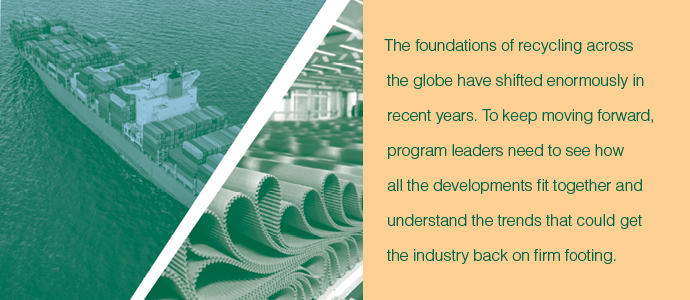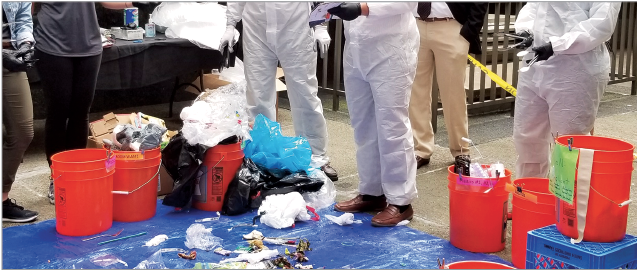
This article originally appeared in the May 2019 issue of Resource Recycling. Subscribe today for access to all print content.
We all know public concern about waste and pollution has grown. The global recycling industry, meanwhile, faces costs and complexity caused, in part, by tightening overseas regulations on waste imports.
This is not a good mix, but the future nonetheless carries much potential, if programs and companies can fully understand and address the scope and interconnected nature of the issues in front of us.
To help professionals get a clear handle (and perhaps a refresher) on it all, let’s take a look at the state of the recycling market, where it’s headed, and the role that nations, individuals and corporate waste generators all play as we aim for an effective recycling model and a more sustainable world.
Understanding industry economics
The first thing to understand is there’s a battle raging between convenience and cost in materials recovery.
Single-stream recycling has made the process easy for the general public, as well as some industry stakeholders. It’s faster and simpler when people don’t have to sort their recyclable materials into separate bins, and, as a result, participation rates increase.
On the flip side, of course, are costly contamination issues. For example, broken glass and non-approved materials end up in the bin, causing trouble for recycling facilities. In fact, Waste Management last year publicly stated about a quarter of all recycling picked up is contaminated and deemed not recyclable through curbside programs. This problem increases the sorting responsibilities that need to happen after recyclables are collected, which then increases overall recycling costs.
Until recently, it’s been relatively easy to offload the sorting responsibility to China and developing countries. But at the start of 2018, China implemented its much-discussed policy of banning some imports and decreasing the contamination limit to 0.5% on those loads still allowed.
We’ve all seen the reports. The so-called Green Sword has left U.S. companies and cities to deal with mounting trash and costs. Massive amounts of unsorted, contaminated recyclables are stuck in America with nowhere to go, since municipalities often lack the budget to hire people to conduct costly sorting and cleaning.
And it’s not just the United States facing recycling issues. The European Union has also been forced to make changes in response to market shifts, resulting in aggressive policy action. Late last year, the EU released waste goals for 2030, including a move away from a variety of single-use plastics (see page 32 for more on the EU’s waste push).
Meanwhile, across Asia, countries are seeing the impact of China’s recycling ban in the form of more recycled materials heading their way for processing. In countries like Vietnam, Thailand and Malaysia, it has been reported that excess plastic is starting to impact environmental health in much the same way it was impacting China’s. Ultimately, China’s policy push created a ripple effect that disrupted the recycling outlook worldwide.

Waste audits are becoming increasingly important in both the residential and commercial spheres.
Trends shaping the future of recycling
So what exactly can we expect from here?
Predicting the future is always difficult, particularly in an industry where markets are in turmoil. But it seems inevitable that recycling stakeholders will be trying to create behavioral change among both consumers and companies with respect to waste. Below are seven different strategies that could get put into play in one way or another.
- A return to dual-stream recycling: Due to stringency around contamination of recyclables, the future could see a return to increased separation responsibilities on the part of residents and other material generators. And some smaller U.S. communities have already done away with their single-stream systems in favor of multi-stream. In addition, as more municipalities are requiring LEED certification of new buildings, an increase in zero-waste certified facilities will likely follow, as well as acceleration toward the circular economy mindset in corporate America.
- Waste visibility through audits: Waste audits can help program leaders better understand the actions of material generators. By analyzing waste stream data, businesses are able to make operational changes, avoid non-compliance fines, increase diversion, uncover bottom-line savings opportunities and change employee and consumer behavior. On a fundamental level, informed public education is vital and a key part of the strategy for national groups like Keep America Beautiful. If people can be taught to understand what they are able to recycle and how to recycle appropriately, the industry will make serious strides. Audits are a valuable first step in this process.
- Businesses doing what regulation can’t: While government and the individual are key to recycling efforts, corporations are routinely overlooked in discussions about pathways to greater sustainability. Large companies are becoming more and more aware of their role in waste, especially with the rising trend of sustainability reporting at the corporate level. Investors want to know what companies are actively doing to help the environment, millennials crave workplaces built around green thinking and consumers want to support brands that reflect their own personal values. Waste is a particularly visible and relatable way for people to connect with a company’s efforts to decrease its environmental footprint. We should expect even more recycling-related goal-setting and follow-through on the part of corporations.
- A sustainable supply chain: Related to the point above is the fact that companies are examining their supply chains closely to better understand sustainability issues. With the increased cost of recycling and the scarcity of places available to process recyclables, companies will begin to move up the supply chain to try to reduce the amount of waste they produce. Manufacturing, along with recycling, will need to make major changes in the near future, as both the U.S. and other countries attempt to resolve recycling and sustainability issues raised by China’s restrictions.
- Progressive action by brands: As stated above, consumer-facing companies know they need to develop sustainability credibility to remain relevant, and some noteworthy actions are happening now in the luxury retail category. Some retailers, for example, are looking into mushroom-based compounds to reduce carbon output. Recently, several significant brands solidified partnerships with Loop, a circular shopping platform leveraging reusable packaging. This kind of circular product model is becoming more popular as corporations begin to look higher in the supply chain to reduce waste.
- Legislation prompting action: This article has already noted some of the EU policy efforts that have resulted from the changing sustainability and recycling landscape, and similar developments have been seen in the U.S., with a number of jurisdictions passing legislation of late that puts the onus on corporations to increase efforts. For example, California now requires manufacturers and others that generate large volumes of mixed waste to audit materials. That step aims to diagnose where excess waste is being created and how to change behavior to encourage sustainability. San Francisco takes things a step further: If large waste generators are found to be non-compliant with the current city recycling requirements, they are obligated to hire on-site zero-waste coordinators for one year, at their own expense.
- Technological advances: Across the materials management spectrum, there is significant new technology being released to help a range of entities stay ahead of today’s challenges. The rapid rise of artificial intelligence in materials separation has brought a new wave of machinery and data-gathering capabilities to recycling facilities. Meanwhile, optical sortation has continued advancing and is now helping processors respond to contamination requirements in fiber and other markets. On the corporate side, smart meters and composting technology can help businesses of all kinds track and reduce waste and limit waste costs. Invariably, as more innovation occurs in the recycling sector, these technologies will become more widely available.
A more resilient system
Recycling has for years been embedded in daily life, and it’s hard to see that reversing, even with the challenges in front of us. The key will be helping waste generators make small, incremental shifts to optimize the waste diversion infrastructure we already have in place.
Companies must continue to enhance their holistic waste diversion programs and continue to look for circular economy-inspired opportunities. Consumers, meanwhile, need to be more mindful about the waste they generate by opting to use fewer disposable materials and developing clean and responsible practices when they move materials into the recycling system.
Bringing such transitions to fruition is certainly easier said than done, but they are essential to the continued development of our collective system of materials management. Only when that system is on firm footing will we move forward toward a more sustainable world.
Lani Aviado is the sustainability solutions director at ENGIE Insight, a consulting company that helps businesses achieve successful sustainable resource management initiatives. She can be contacted at [email protected].

